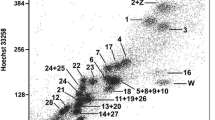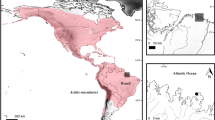Abstract
Like various other diurnal birds of prey, the world's largest eagle, the Harpy (Harpia harpyja), presents an atypical bird karyotype with 2n=58 chromosomes. There is little knowledge about the dramatic changes in the genomic reorganization of these species compared to other birds. Since recently, the chicken provides a “default map” for various birds including the first genomic DNA sequence of a bird species. Obviously, the gross division of the chicken genome into relatively gene-poor macrochromosomes and predominantly gene-rich microchromosomes has been conserved for more than 150 million years in most bird species. Here, we present classical features of the Harpy eagle karyotype but also chromosomal homologies between H. harpyja and the chicken by chromosome painting and comparison to the chicken genome map. We used two different sets of painting probes: (1) chicken chromosomes were divided into three size categories: (a) macrochromosomes 1–5 and Z, (b) medium-sized chromosomes 6–10, and (c) 19 microchromosomes; (2) combinatorially labeled chicken chromosome paints 1–6 and Z. Both probe sets were visualized on H. harpyja chromosomes by multicolor fluorescence in situ hybridization (FISH). Our data show how the organization into micro- and macrochromosomes has been lost in the Harpy eagle, seemingly without any preference or constraints.



Similar content being viewed by others
References
Bed'Hom B (1999) Etude des Caryotypes Atypiques des Accipitridae (Aves, Falconiformes) par Cytogenetique Classique et Molécular, et Modélisation de leur Èvolution. Ph.D. Thesis, University of Tours, France
Bed'Hom B, Coullin P, Guillier-Gencik Z, Moulin S, Bernheim A, Volobouev V (2003) Characterization of the atypical karyotype of the black-winged kite Elanus caeruleus (Falconiformes: Accipitridae) by means of classical and molecular cytogenetic techniques. Chromosome Res 11:335–343
Burt DW (2002) Origin and evolution of avian microchromosomes. Cytogenet Genome Res 96:97–112
de Boer LE (1980) Do the chromosomes of the kiwi provide evidence for a monophyletic origin of the ratites? Nature 287:84–85
de Lucca EJ, Rocha GT (1992) Citogenética de Aves. Bol Mus Para Emilio Goeldi, Zool 8:33–68
Derjusheva S, Kurganova A, Habermann F, Gaginskaya E (2004) High chromosome conservation detected by comparative chromosome painting in chicken, pigeon and passerine birds. Chromosome Res 12:715–723
Gill JE, Jotz MM, Young SG, Modest EJ, Sengupta SK (1975) 7-Amino-actinomycin D as a cytochemical probe. I. Spectral properties. J Histochem Cytochem 23:793–799
Griffin DK, Habermann F, Masabanda J, O'Brien P, Bagga M, Sazanov A, Smith J, Burt DW, Ferguson-Smith M, Wienberg J (1999) Micro- and macrochromosome paints generated by flow cytometry and microdissection: tools for mapping the chicken genome. Cytogenet Cell Genet 87:278–281
Guttenbach M, Nanda I, Feichtinger W, Masabanda JS, Griffin DK, Schmid M (2003) Comparative chromosome painting of chicken autosomal paints 1–9 in nine different bird species. Cytogenet Genome Res 103:173–184
Habermann FA, Cremer M, Walter J, Kreth G, von Hase J, Bauer K, Wienberg J, Cremer C, Cremer T, Solovei I (2001) Arrangements of macro- and microchromosomes in chicken cells. Chromosome Res 9:569–584
Hoffmann R, Faust R, Weinand U, Hoffmann-Fezer G (1976) Chromosomenuntersuchungen an fünf Spezies der Ordnung Falconiformes. Zool Gart (Jena) 46:99–107
Holmquist GP (1992) Chromosome bands, their chromatin flavors, and their functional features. Am J Hum Genet 51:17–37
Howell WM, Black DA (1980) Controlled silver-staining of nucleolar organizer regions with protective colloidal developer: a 1-step method. Experientia 36:1014
International Chicken Genome Sequencing Consortium (2004) Sequence and comparative analysis of the chicken genome provide unique perspectives on vertebrate evolution. Nature 432:695–716
Kasai F, Garcia C, Arruga MV, Ferguson-Smith MA (2003) Chromosome homology between chicken (Gallus gallus domesticus) and the red-legged partridge (Alectoris rufa): evidence of the occurrence of a neocentromere during evolution. Cytogenet Genome Res 102:326–330
Masabanda JS, Burt DW, O'Brien PC, Vignal A, Fillon V, Walsh PS, Cox H, Tempest HG, Smith J, Habermann F, Schmid M, Matsuda Y, Ferguson-Smith MA, Crooijmans RP, Groenen MA, Griffin DK (2004) Molecular cytogenetic definition of the chicken genome: the first complete avian karyotype. Genetics 166:1367–1373
Matsuda Y, Nishida-Umehara C, Tarui H, Kuroiwa A, Yamada K, Isobe T, Ando J, Saito T, Agata K (2004) Karyological relationships between birds and reptiles inferred from comparative gene mapping. 15th International Chromosome Conference, Brunel University, UK. Chromosome Res, pp 45
Meyne J, Ratliff RL, Moyzis RK (1989) Conservation of the human telomere sequence (TTAGGG)n among vertebrates. Proc Natl Acad Sci U S A 86:7049–7053
Moorhead PS, Nowell PC, Mellman WJ, Battips DM (1960) Chromosome preparations of leucocytes cultured from human peripheral blood. Exp Cell Res 20:613–616
Raudsepp T, Houck ML, O'Brien PC, Ferguson-Smith MA, Ryder OA, Chowdhary BP (2002) Cytogenetic analysis of California condor (Gymnogyps californianus) chromosomes: comparison with chicken (Gallus gallus) macrochromosomes. Cytogenet Genome Res 98:54–60
Rodionov AV (1996) Micro vs. macro: structural–functional organization of avian micro-and macrochromosomes. Genetika 32:597–608
Schmid M, Nanda I, Guttenbach M, Steinlein C, Hoehn M, Schartl M, Haaf T, Weigend S, Fries R, Buerstedde JM, Wimmers K, Burt DW, Smith J, A'Hara S, Law A, Griffin DK, Bumstead N, Kaufman J, Thomson PA, Burke T, Groenen MA, Crooijmans RP, Vignal A, Fillon V, Morisson M, Pitel F, Tixier-Boichard M, Ladjali-Mohammedi K, Hillel J, Maki-Tanila A, Cheng HH, Delany ME, Burnside J, Mizuno S (2000) First report on chicken genes and chromosomes 2000. Cytogenet Cell Genet 90:169–218
Seabright M (1971) A rapid banding technique for human chromosomes. Lancet 2:971–972
Shetty S, Griffin DK, Graves JA (1999) Comparative painting reveals strong chromosome homology over 80 million years of bird evolution. Chromosome Res 7:289–295
Shibusawa M, Nishibori M, Nishida-Umehara C, Tsudzuki M, Masabanda J, Griffin DK, Matsuda Y (2004a) Karyotypic evolution in the Galliformes: an examination of the process of karyotypic evolution by comparison of the molecular cytogenetic findings with the molecular phylogeny. Cytogenet Genome Res 106:111–119
Shibusawa M, Nishida-Umehara C, Tsudzuki M, Masabanda J, Griffin DK, Matsuda Y (2004b) A comparative karyological study of the blue-breasted quail (Coturnix chinensis, Phasianidae) and California quail (Callipepla californica, Odontophoridae). Cytogenet Genome Res 106:82–90
Sumner AT (1972) A simple technique for demonstrating centromeric heterochromatin. Exp Cell Res 75:304–306
Tegelstrom H, Ebenhard T, Ryttman H (1983) Rate of karyotype evolution and speciation in birds. Hereditas 98:235–239
Acknowledgements
The authors would like to thank Thomas Cremer for his continuous support.
Author information
Authors and Affiliations
Corresponding author
Additional information
Communicated by E.A. Nigg
Rights and permissions
About this article
Cite this article
de Oliveira, E.H.C., Habermann, F.A., Lacerda, O. et al. Chromosome reshuffling in birds of prey: the karyotype of the world's largest eagle (Harpy eagle, Harpia harpyja) compared to that of the chicken (Gallus gallus). Chromosoma 114, 338–343 (2005). https://doi.org/10.1007/s00412-005-0009-5
Received:
Revised:
Accepted:
Published:
Issue Date:
DOI: https://doi.org/10.1007/s00412-005-0009-5




